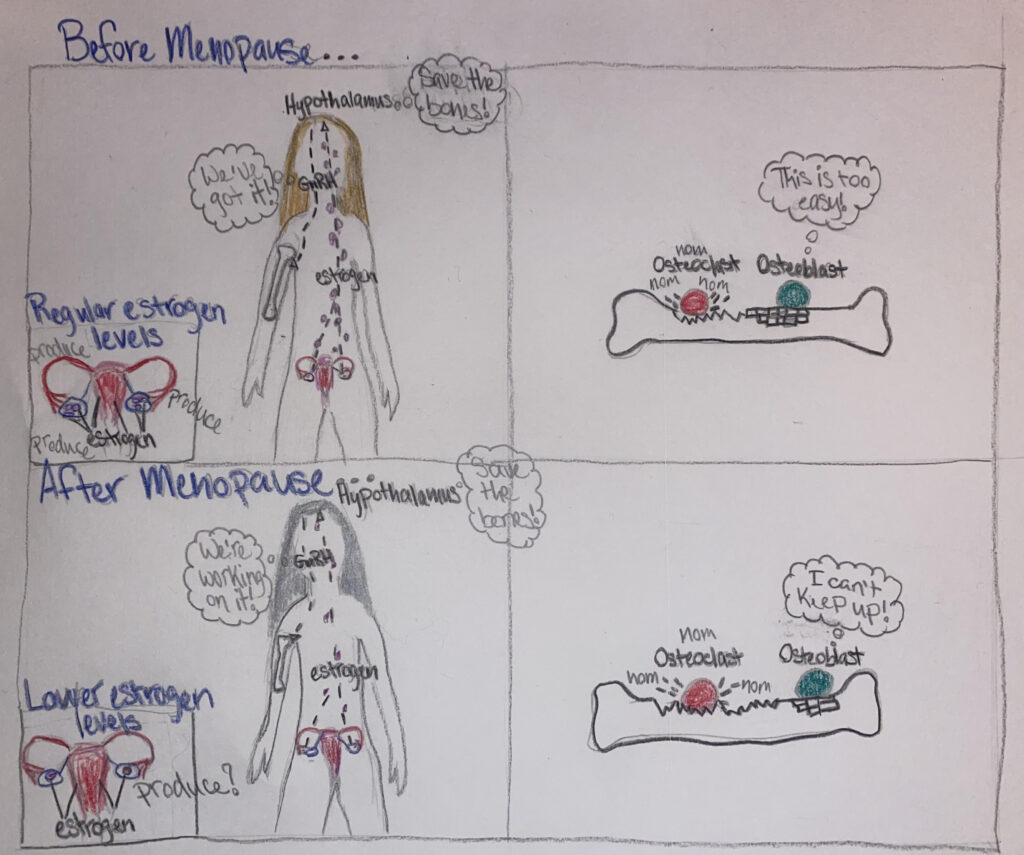
The objective my project covers is explaining how bone development is hormonally regulated. The purpose of my project is to demonstrate how bones are hormonally regulated in the female body. It is a close up representation of what is happening to the bone through a short “comic strip” type of depiction. While it is a scientific based representation that looks literal, I added thought bubbles both to animate what is happening in the pictures and to help with understanding of the process that happens. This is to make the project creative and nonliteral while getting the scientific objective across. My project demonstrates the where, what, and how Menopause affects the bone in a lighter way. Because of the change in hormones as well as what it is like before Menopause. In the before Menopause stage the picture shows the ovaries producing normal levels of estrogen. It then shows the estrogen that then travels through the body to the brain (hypothalamus). Ultimately it shows that it is transmitted into Gonadotropin-releasing hormone (GnRH), which travels to the bone, increasing the osteoblasts functional capacity allowing the osteoblasts to fight off the destruction of the osteoclasts (Mills, Yang, Nielsen, Kassem, Dhillo, Comninos, 2021). After Menopause the ovaries produce significantly less estrogen. Because of this the osteoblasts can’t fight off the osteoclasts’ destruction. With the inability for the osteoblasts to repair the bone as fast as the osteoclasts destroy the bone, this leaves the bones weak and fragile. This causes the bone to be more susceptible to fractures and breaks. Because bone development is hormonally regulated, specifically reproductive hormones, reproductive disorders are the common cause of low bone mass (Mills, Yang, Nielsen, Kassem, Dhillo, Comninos, 2021). Some examples of reproductive disorders include but not limited to, pregnancy and lactation-associated osteoporosis, hypoglycemia, and premature ovarian insufficiency. Although this is not reflected in my project I think it is important to add more information for the sources I read. Estrogen is one of the significant regulating hormones in bone development for both men and women. It was previously thought that the hormone regulating the male bone had to be testosterone but it has been discovered that the main hormone that regulates the male bone along with testosterone is estrogen (Khosla, Oursler, Monroe, 2012). The growth of bone and the maintenance of bone is regulated by estrogen.
Works Cited
Edouard G Mills, Lisa Yang, Morten F Nielsen, Moustapha Kassem, Waljit S Dhillo, Alexander N Comninos, The Relationship Between Bone and Reproductive Hormones Beyond Estrogens and Androgens, Endocrine Reviews, Volume 42, Issue 6, December 2021, Pages 691–719, https://doi.org/10.1210/endrev/bnab015
Khosla S, Oursler MJ, Monroe DG. Estrogen and the skeleton. Trends Endocrinol Metab. 2012 Nov;23(11):576-81. doi: 10.1016/j.tem.2012.03.008. Epub 2012 May 16. PMID: 22595550; PMCID: PMC3424385.

I like the Comic strip you made. It is a great example of the lack of estrogen in the body and how the bones cannot keep up when the osteoclasts take over and the osteoblasts cannot keep up. Estrogen travels from the ovaries to the hypothalamus.
Before menopause, the estrogen is not there to help the bones heal after osteoclasts damage the bone. After menopause, the estrogen is going to the hypothalamus much slower because the ovaries are not producing enough estrogen. After estrogen reaches the hypothalamus, a hormone is release called Gonadotropin-releasing hormone. This hormone travels to the bone which helps the osteoblast that help fight off the osteoclasts. The osteoclasts take over and damage the bone and the osteoblasts cannot fix the bone in time before more damage occurs. It is called osteoporosis. Osteoporosis is a disease that makes bones weak and fragile due to that lack of estrogen. The lack of estrogen and the higher levels of osteoclasts, leaves the bone brittle and more susceptible to breaking. With low bone mass comes the chances of reproductive issues. These include pregnancy, hypoglycemia, and premature ovarian insufficiency. In her text she comments on men’s bones and what hormones affect them. She says that it is often thought that testosterone is a cause for brittle or weak bones in men but with research, estrogen is still a leading factor in bone loss in men. This comic strip is good because it shows how the estrogen travels in the body and then how the bones grow weak and the osteoblasts cannot keep up with the osteoclasts.